Strong growth in Vienna, slowdown in Austria
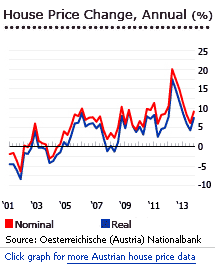 Vienna’s residential property price index rose by 9.1% (7.4% in real terms) during the year to Q4 2013. This is Vienna’s tenth consecutive year of continuous house price hikes, based on Oesterreichische Nationalbank (OeNB)’s figures.
Vienna’s residential property price index rose by 9.1% (7.4% in real terms) during the year to Q4 2013. This is Vienna’s tenth consecutive year of continuous house price hikes, based on Oesterreichische Nationalbank (OeNB)’s figures.
During the latest quarter, house prices in Vienna rose by 2.3% (1.6% in real terms) in Q4 2013, an improvement from the 0.9% (1% in real terms) q-o-q growth recorded in the previous quarter.
In contrast to Vienna’s skyrocketing house price increases, property prices in the rest of Austria rose by only 1.7% (0.1% in real terms) in 2013, and fell by 1.9% (-2.6% in real terms) during the latest quarter.
The divergence between the capital and the rest of Austria is puzzling. It may be partly because it is difficult to build in the centre of Vienna. It may be because the majority (about 70%) of residential real estate in Vienna is owned by institutional investors, i.e., banks and companies. It may also be because in an era of low interest rates, people are putting money into rental properties, and Vienna offers relatively easy renting (though returns are quite moderate).
There has been strong growth in demand to buy larger units (100 square metres (sq. m.) and up) in the city centre. With the limited supply of large units, prices of such apartments have risen faster than smaller-sized units.
Vienna has one of the highest percentages of renter households in the world, with about 75% of homes rented in 2012. In Austria as a whole, households own 56.4% of primary residences, while 41.2% are rented, according to the 2012 Austrian microcensus. Austria’s home ownership rate is way below the EU-27’s average rate of 70.7% (2011).
The high percentage of rented residential properties is due to the large proportion of subsidized low-rent apartments in the general rental market, according to Martin Schneider of the Oesterreichische Nationalbank (OeNB). Limited tax incentives for home ownership also contribute to the high proportion of renters.
House prices in Vienna have been rising consistently since Q3 2004. During the housing boom (2003-2013), house prices in the capital soared by 99.6% (61.7% in real terms). On the other hand, property price changes in the rest of Austria have been erratic ever since the index was assembled in 2000. House prices rose by just 37.1% (11.1% in real terms) from 2003 to 2013.
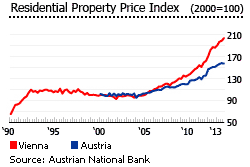
As of Q3 2013, construction activity in Austria increased, with 35,883 dwellings authorized, 23.8% more than in Q3 2012. The gross floor area authorized rose by 16.7% y-o-y to 9 million sq. m. in Q3 2013, according to Statistics Austria.
Although the Austrian market remains robust, it is expected that property prices will most likely to stabilize this year, according to Austrian Real Estate Association’s general manager Anton Holzapfel.
The highest average new apartment price was in Vienna at EUR 3,598.62 (US$ 4,984.09) per sq. m., up by 9.1% from the previous year, according to the real estate agency Rellox. Vienna was followed by Salzburg, which experienced a 5.3% increase from the previous year to EUR 3,321.44 (US$ 4,600.19) per sq. m. The cheapest new apartments can be found in Burgenland, where the average price fell by 0.02% to EUR 1,583.90 (US$ 2,193.70) per sq. m.
Luxury prices in Vienna range from EUR 15,000 to EUR 18,000 per sq. m. The rate can go up to EUR 20,000 per sq. m. for prestigious properties in Vienna’s Innere Stadt (Old Town), according to the latest Knight Frank report.
Better rental yields outside Vienna
Austria’s rental market is segmented via tenure, regulation and market forces into a hierarchy of low rents for municipal, other social tenants and long-term incumbents in the private sector, but higher free market rents for recent entrants into the private rental sector (though even the "free" sector is substantially controlled, with maximum rents clearly specified by the authorities). Global Property Guide’s figures cover the "free" market sector only.
Rental yields in Vienna’s Innere Stadt (Old Town) are poor as compared to the other upscale areas in Vienna, with yields ranging from 1.78% to 2.61%, according to Global Property Guide research of August 2013. Other parts of Vienna have higher yields of from 3.09% to 4.54%. Smaller apartments earn the highest rental returns, while bigger ones have lower rental returns.
Better yields can be found outside Vienna. Apartments in Salzburg have yields ranging from 3.59% to 5.14%. Apartments in Graz have similar gross rental yields, ranging from 3.9% to 5.52%.
An oversupply of rental units during the 1990s led to a fall in rents. The rent decline stopped in 2000 and rents even rose briefly until 2001, but fell once more in 2002.
Almost no rent increases have taken place since then and none can be expected in the near future, according to Colliers, even though the demand for rental apartments has recently increased, mainly for 50 sq. m. to 80 sq. m. apartments (single apartments with rents of up to EUR 1,500), and for apartments larger than 140 sq. m.
Housing supply
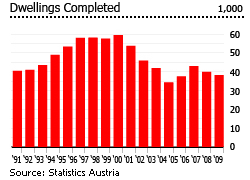
The number of new dwellings built in Austria fell to about 40,000 units a year during 2001-2004, from around 66,000 units yearly in the 1990s, as a result of a boom-and-bust cycle. Construction volumes have still not recovered. Total dwellings authorized numbered 39,774 in 2012, and 45,665 dwellings the previous year, according to Statistics Austria.
Variable interest rates are the rule

Most new housing loans in Austria are on variable rates, not fixed, making the housing market quite sensitive to interest rate changes. Indeed, the total amount of new housing loans with variable interest rates increased from 53% of all new housing in 2004, to around 82% in 2013.
Interest rates continue to decline, following European Central Bank key rates. As of December 2013, the following average housing loan rates applied in Austria:
- Interest rate fixation (IRF) of up to 1 year: 2.36%
- IRF over 1 and up to 5 years: 2.27%
- IRF over 5 years and up to 10 years: 3.38%
- IRF over 10 years: 3.44%
Following the drop in European Central Bank key rates, the variable housing loan interest rate dropped to around 4% - 4.5% from 2003 to 2006. After an uptick, variable rates further dropped to 2.56% in December 2010, amidst the global financial meltdown.
The ECB key rate is currently at its all-time low of 0.25%, due to a surprise 25-basis-points rate cut made by the ECB in November 2013, in response to the sharp decline of inflation to 0.7% in October the same year. Earlier in 2013, the ECB also made a rate cut from 0.75% to 0.50%, also due to lower inflation, as well as rising unemployment.
Austria´s mortgage market remains small
Austria has a smaller mortgage market than other European countries. Mortgage loans outstanding were 35.3% of GDP in 2013 (EUR 111.2 billion, equivalent to US$ 154.1 billion), having grown from EUR 41.1 billion (US$ 57 billion) or 19.7% of GDP in 2000. The average mortgage market size in the EU is 50% of GDP.
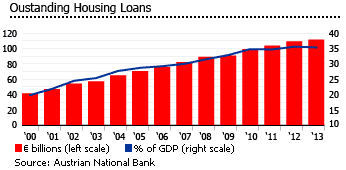
Mortgage growth was accompanied by an increase in foreign-currency denominated loans from around 7% of total housing loans in 2000, to about 20% in 2013.
Economic expansion in 2014
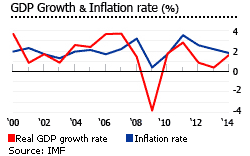
In the past two years, the Austrian economy has stagnated, with growth rates at about 0.9% in 2012 and 0.4% in 2013. However these sluggish growth rates are actually better than most other European countries, as the euro zone’s GDP fell by 0.4% in real terms, according to Eurostat.
The economy is predicted to expand by 1.6% in 2014 and by 1.9% in 2015, due to the recovery of the global economy and the expansion of domestic demand, according to the Oesterreichische Nationalbank (OeNB). OeNB predicts exports will grow significantly in the next two years, providing important support to Austria’s economy.
The Austrian economy is mainly driven by exports, mostly to its biggest trading partner, Germany. More than 75% of Austria’s exports go to Europe, 30% to Germany. Austria experienced relatively strong economic growth from 2004 to 2007 with an average annual GDP growth of 3.1%. After contracting by 3.8% in 2009, the economy emerged from recession with growth rates of 2.31% in 2010 and 2.7% in 2011.
Austria’s budget deficit was projected to be at around 2.3% in 2013, but final results are expected to be better due to a one-off income from a mobile frequency auction and higher tax revenues. New finance minister Michael Spindelegger has said that the government is targeting a structural budget deficit of 1.5% of GDP in 2014. Sovereign debt was around EUR 239.9 billion or about 77.1% of GDP in Q3 2013, according to Statistics Austria, well above the 60% target.
Austria had the EU´s lowest unemployment rate in January 2014, at 4.9% (Eurostat definition), a decline from 5% recorded in December 2013.
Inflation was 1.5% in January 2014, after 2% average inflation in 2013, and 2.4% in 2012. OeNB’s Governor, Ewald Nowotny, predicts inflation to decline to 1.4% in 2014, before rising slightly to 1.6% in 2015.